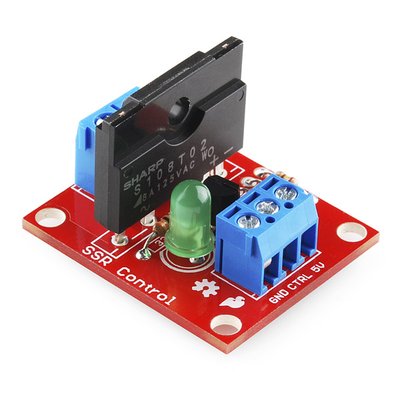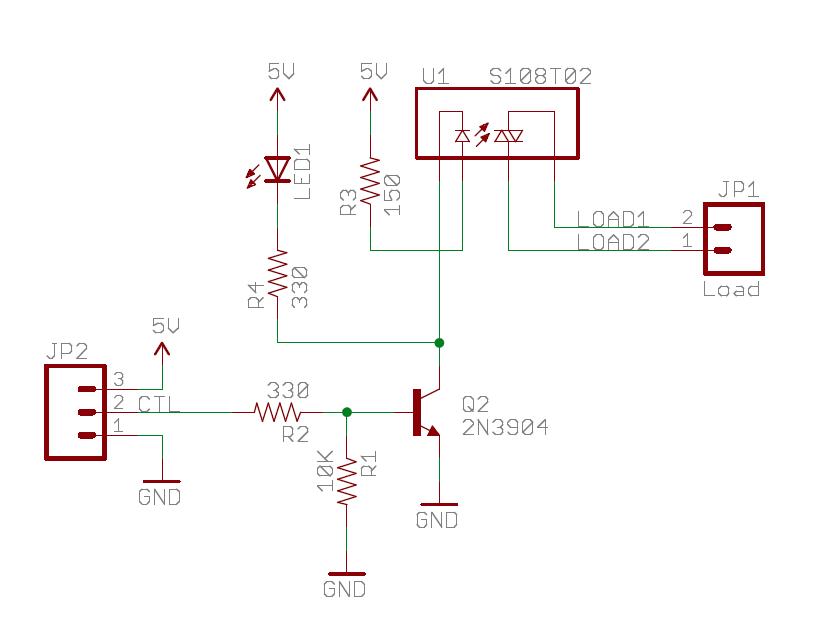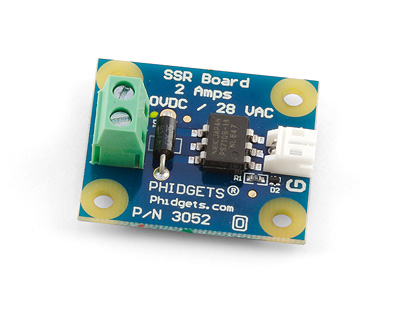SSR Breakout Boards
The Sparkfun Solid State Relay (SSR) Breakout Board is shown below. An SSR works like a relay but is built using semiconductors for switching. It will run off of mbed's VU 5V supply and works with any mbed digital output pin.

Sparkfun Solid State Relay Board
The schematic is shown below for the Sparkfun Solid State Relay board seen above. It uses a S108T02 Sharp SSR module and can switch 125VAC at 8A (AC only - not DC). Note that it also requires an on-board driver circuit, and the external wire connections are the same as most relay boards. A transistor driver circuit is used to control the SSR module. Any digital out pin can be used to control the SSR (connects to the control input (CTL - JP2-2) of the SSR driver circuit). The SSR module has a TRIAC output with optically isolated control inputs.

Schematic of SSR board
Safety Note on High Voltages
A high voltage power line shorted to a digital logic circuit on a breadboard can blow up an entire computer system, or cause electrocution if touched.
For safety, keep the wires for any high voltage and/or high current devices well away from the breadboard and do not touch them when power is on. Even a momentary wire short can blow things ups. An inline fuse and even a GFI breaker is not a bad idea. Long before a standard household AC circuit breaker trips, electronic parts will blow out with a short. Make sure that the bottom side of the PCB does not short out on any metallic surfaces. Breadboard contacts and small jumper wires only handle about one amp. The relay boards typically use screw terminals to attach the larger wires needed for the external device. Just driving the coil of a large relay requires most of the additional current that can be supplied to mbed via the USB cable, so an external DC power supply will likely be needed to power the relay coils and the load of the external device. For electrical isolation, when using a relay to control external AC devices or high voltage DC devices, do not connect the grounds on the power supplies from the control side to the load side.
Here is an example program the turns the SSR on and off every 4 seconds.
#include "mbed.h"
DigitalOut myled(LED1);
DigitalOut Ctrl(p8);
int main() {
while(1) {
Ctrl = 1;
myled = 1;
wait(2);
Ctrl = 0;
myled = 0;
wait(2);
}
}
Wiring
| mbed | SSR board | external AC load |
|---|---|---|
| VU(5v) | VCC | |
| Gnd | Gnd | |
| P8 | CTL | |
| screw terminal 2 | load 1 | |
| screw terminal 2 | load 2 |
For the demo, one of the wires in a 2-wire AC extension cord was cut, pulled apart, stripped back, and each end attached to one of the two black screw terminals used for the load. The lamp was them plugged into the extension cord.
SSR controlling a household AC lamp using mbed
In the video above running the demo code, the SSR turns the lamp on and off every 4 seconds. Note the lack of an audible click (unlike a mechanical relay), and the indicator LEDs changing, mbed LED1 and the green LED on the SSR board. Some SSRs can dim lights, but this one does not have the phase control sense circuit needed. It does have a zero crossing circuit to reduce RF noise emissions. A heat sink for the SSR module is needed at anything near the rated load.
The Phidgets SSR board seen below can switch both AC and DC voltages at lower voltage and current levels. It uses a small NEC/CEL SSR IC. Instead of a TRIAC, two MOSFETS are used for switching, so it can switch DC or AC.

Phidgets SSR board
Drivers, Relays, and Solid State Relays describes some other options and circuits to drive high current and/or high voltage AC and DC devices.
5 comments on SSR Breakout Boards:
Please log in to post comments.

Good time of a day! Why can't I just connect PWM-out of my MBED to the '+' of an SSR-relay? Why should I use driver circuit with a transistor? I use PWM-multiplier (TLC5940) and it can provide enough power for each of 16 output. I bought 16x Sharp S202S02F relays, whose ON voltage is less than 3V (that we can get from PWM-out), and needed current is less than 120 mA.